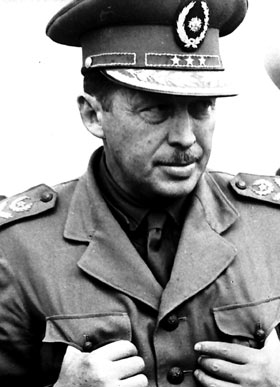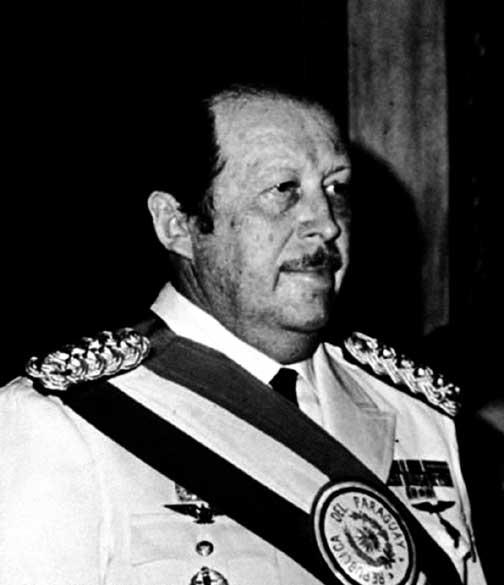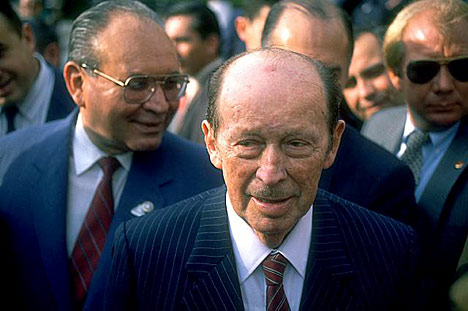<Back to Index>
- Physician Bernardino Ramazzini, 1633
- Sculptor Benvenuto Cellini, 1500
- Dictator of Paraguay Alfredo Strössner Matiauda, 1912
PAGE SPONSOR



Alfredo Stroessner Matiauda, whose name is also spelled Strössner or Strößner (November 3, 1912, Encarnación – August 16, 2006, Brasília), was a Paraguayan military officer and dictator from 1954 to 1989. His lengthy rule was the 12th-longest ever by state leaders other than monarchs.
Stroessner's parents were Hugo Strößner, who emigrated from Hof, Bavaria, Germany, and worked as an accountant for a brewery, and Heriberta Matiauda, who grew up in a wealthy Paraguayan family. He joined the Paraguayan army in 1929, becoming a lieutenant in 1931. During the Chaco War against Bolivia (1932 – 1935) he enlisted as an artillery cadet and fought in the Battle of Boquerón. After the war he rose steadily in rank. In the Paraguayan Civil War he commanded the artillery division at Paraguarí that ensured President Moríñigo won by staying loyal and destroying a working class rebel area of Asunción. He eventually became a brigadier and the youngest general officer in South America in 1948.
Stroessner objected to President Federico Chávez' plans to arm the national police and threw him out of office in a coup d'état on May 4, 1954. After a brief interim presidency by Tomás Romero, Stroessner was the only candidate in a special election on July 11 to complete Chávez' term. He was reelected seven times — in 1958, 1963, 1968, 1973, 1978, 1983, and 1988. He appeared alone on the ballot in 1958. In his other elections, he won by implausibly high margins (well over 80 percent in many cases). He served for 35 years, with only Fidel Castro having a longer tenure among 20th century Latin American leaders.
Soon after taking office, Stroessner declared a state of siege and suspended constitutional freedoms. It was renewed every 90 days for the rest of his term, and was only lifted during elections. A devoted anti-Communist, he justified this action as a necessary tool to protect the country. Stroessner's strong anti-communism made him a friend to United States interests for most of his rule. As leader of the Colorado Party, Stroessner exercised nearly complete control over the nation's political scene. Although opposition parties were nominally permitted after 1962 (the Colorado Party had been the only legal party in the country since 1947), Paraguay remained for all intents and purposes a one-party state. Elections were so heavily rigged in favor of the Colorados that the opposition had no realistic chance of winning, and opposition figures were subjected to varying degrees of harassment.
While Stroessner's rule saw more stability than any living Paraguayan had ever known, it came at a high cost. The government's human rights record was considered particularly poor. Stroessner supported the U.S. invasion of Dominican Republic and even offered to send troops to support the U.S. in Vietnam. His regime is also blamed for torture, kidnappings and corruption, of which the "terror archives", discovered in 1992 in Lambaré suburb of Asunción, gave proof; he did not dispute charges of corruption at some levels in his government. After execution, bodies were often just dumped in the Chaco or the Rio Paraguay. The Aché tribe of eastern Paraguay surrendered in August 1959 and was enslaved. In 1974 the UN accused Paraguay of Slavery and Genocide. Pastor Coronel was the chief of the pyragüés (hairy-footed in Guaraní) or secret police. He would interview people in a pileta, a bath of human excrement or ram electric cattle prods up their rectums. The Secretary of the Paraguayan Communist Party was torn apart with a chainsaw while Stroessner listened on the phone.
Stroessner was careful not to show off or draw attention from jealous generals or foreign journalists. He avoided rallies and took simple holidays in Patagonia. He did become more tolerant of opposition as the years passed, but there was no change in the regime's basic character.
Strong Paraguayan - U.S. relations continued until the Carter Administration emphasized a foreign policy that recognized human rights abuses. The Reagan Administration boycotted the country as well.
During Stroessner's rule, no Communist nations had embassies in Paraguay, with the sole exception of non-aligned Yugoslavia.
Stroessner made many state visits, including to Emperor Hirohito of Japan, President Lyndon Johnson of the United States, President Charles de Gaulle of France, to South Africa and several visits to West Germany, although over the years his relations with West Germany deteriorated. Since he had always been known as pro-German, this worsening of relations, combined with his feeling that the U.S. had abandoned him, were regarded as personal blows to Stroessner.
It
is assumed that the Roman Catholic
Church is the
only reason Stroessner did not have absolute control over the country. After the destruction of Asunción
University in
1972 by police, the Archbishop of Paraguay Ismael
Rolón Silvero excommunicated
the minister of the interior and the chief of police, and proscribed
the celebration of Holy Mass in a sign of protest
against the Stroessner regime. When
Pope John Paul
II visited
Paraguay in 1988, his visit bolstered what was already a robust
anti-Stroessner movement within the country. Stroessner
was known for several positive economic policies, including the
building of the largest hydroelectric power plant in the world in Itaipu,
developing Paraguay's
economy:
although Paraguay received only 15% of the contracts, it was a major
factor allowing the country to have the highest rate of growth in Latin
America for most of the 1970s.
Stroessner
also dedicated large proportions of the Paraguayan national budget to
the military and police apparatus, both fundamental to the maintenance
of the regime. According to a 1963 article from Time magazine, Stroessner spent
33% of the 1962 annual budget on army and police, 15% for education,
and 2% for public works. There was no income tax and
public spending was the smallest percentage of GDP in Latin America. Furthermore
the construction of the Itaipu Dam, as well as the subsequently built Yacyretá
Dam on
the Paraguay - Argentina Border, displaced thousands of Paraguayans,
pushing them from their home, often without any restitution. The
Itaipu Dam displaced at least 80,000 Paraguayans, and the
Yacyretá will have displaced at least that many by December 2008. 160 workers died building the
Itaipu Dam. Stroessner
was also known for many infrastructure projects that improved the
country's highway system. Another programme that Stroessner supported
was the granting of 20 hectares of arable lands for a nominal price to
any soldier who completed military service, provided that the soldier
would use the land for farming purposes. Over 10,000 soldiers took up
this offer. Most impressive was the fact that by the
end of the Stronato, the second biggest city was Puerto Flor
de Lis (renamed "Puerto Presidente Stroessner," then "Ciudad
del Este"), founded just 32
years before. On
February 3, 1989, only a few months after being elected to his ninth
full term, Stroessner was ousted by a coup
d'état led
by General
Andrés Rodríguez. One reason for the coup was that
the generals feared one of Stroessner's sons would succeed him. Of the
two, Freddie was a cocaine addict and Gustavo was
loathed for being a pilot and a homosexual. A more outlandish rumour
was that Lino Oviedo threatened
Rodriguez with a grenade if he did not launch the coup. Stroessner was
with his mistress when he heard of the coup. Unfortunately, so was the
general with the keys to Stroessner's tanks. The two generals fought a
brief artillery duel over Asuncion. After the coup, Stroessner fled to Brazil,
where he lived in exile for the next seventeen and a half years. The
eastern city Puerto Flor de Lis, which had been renamed Puerto
Presidente Stroessner in his honor, in 1989 was again renamed Ciudad del Este. Asunción's
airport had been named after him during his regime, but was later
renamed Silvio
Pettirossi International Airport. Paraguayans
remain divided on Stroessner and his controversial legacy. Many feel a
strong distaste for him, perceiving him as a corrupt, authoritarian
dictator. Those who defend his legacy cite the political stability and
economic progress under his rule. Stroessner
died on August 16, 2006, in Brasília,
at the age of 93. The immediate cause of death was a stroke.
He had been suffering from pneumonia after undergoing a hernia operation. The Paraguayan government
preemptively dismissed any suggestions for honoring the late president
within Paraguay. He
tried to manage a return to Paraguay before his death, so he could die
in his homeland, but he was rebuked and threatened with arrest by the
government. By
coincidence, on the very day of his death, the "Museum of Memory" was
opened at the place where Stroessner's "Dirección Nacional de
Asuntos Técnicos" (better known as 'la Técnica') operated
its clandestine torture centre from 1956.
